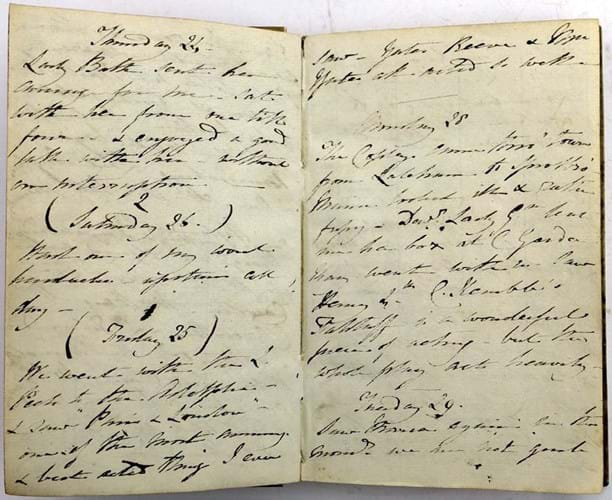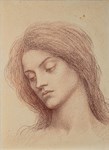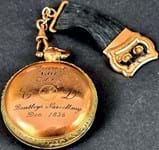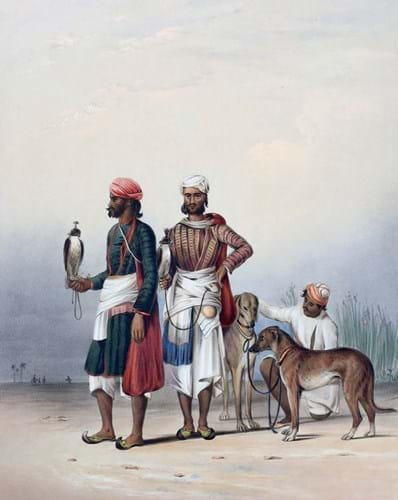
Plate from a fine copy of Portraits of the Princes & People of India by Emily Eden, £29,000 at Gorringe’s.
Politics entered the privileged life of aristocratic novelist and poet Emily Eden (1797-1869) in the most dramatic way in 1835.
When her brother George Eden, 1st Earl of Auckland, was appointed governor-general of India, she and her sister Frances were obliged to leave the comfort of Ham House in Richmond for Calcutta. Emily would remain there for six years, acting as the de facto ‘first lady’ to her unmarried brother.
A prolific diarist with a sharp-eye and occasionally sharp tongue, Eden would document their residency in the jewel of the empire from 1836 to 1842 through two works: the travelogue published in 1866 as Up the Country and her correspondence published in 1872 as Letters from India.
Artistic talent
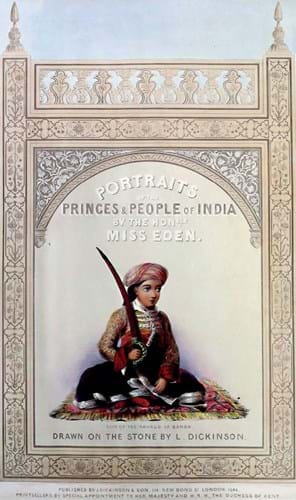
Plate from a fine copy of Portraits of the Princes & People of India by Emily Eden, £29,000 at Gorringe’s.
Additionally, she displayed considerable artistic talent, producing a series of Indian sketches that were worked up on her return to England in 1842 and privately printed in four parts by J Dickinson & Son in 1844 as Portraits of the Princes & People of India.
The 24 plates feature the Indian rulers and their families that Lord Auckland and his 12,000-strong retinue encountered during a tour of the Upper Provinces from October 1837 to February 1840.
The copy offered for sale by Gorringe’s (25% buyer’s premium) in Lewes on March 12 was one of the select few volumes that were heightened with bodycolour and gum-Arabic. Unbound (as issued) in its original purple morocco and cloth portfolio, with very few exceptions the images were remarkably bright and unaffected by spotting.
It was part of a remarkable group of material related to Emily’s life and the Indian subcontinent that had been accumulated by a Sussex family in the 1970s-80s.
Two decades ago, when the plate book market was stronger than today, an equivalent copy of Portraits sold for £55,000 (Christie’s, September 2001). However, more recently, the copy in the Bobins sale at Christie’s in July 2023 took £24,000 while a set of the 24 plates (with contemporary colouring but now detached and framed) was sold at Sworders as part of the Elveden Hall sale last September for £7500.
Gorringe’s copy, purchased by the Sussex vendor from Sotheby’s in 1985, was estimated at £25,000- 35,000 and hammered at £29,000.
The majority of Eden’s original watercolours created in India were auctioned at Christie’s in 1906 when they were acquired by Quaritch for Lord Curzon, who later presented them to the Victoria Memorial Hall in Calcutta.
The British Library has just a single watercolour study for one of her lithographic plates.
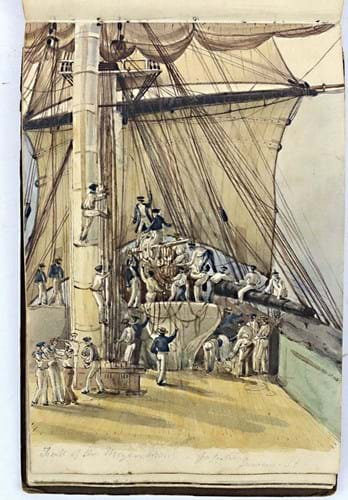
Watercolour depicting Heaving the Lead (sailors on board the Jupiter repairing a mast broken in a storm off Cape Town in January 1836) taken from a sketchbook by Emily Eden sold at £24,000 at Gorringe's.
However, at Gorringe’s the same source yielded a sketchbook that chronicled the voyage of the Eden family (plus six servants, a physician and several pets including Emily’s spaniel Chance) from Portsmouth to Calcutta from October 3, 1835, to March 4, 1836.
The 6 x 9in (16 x 23cm) pages included a total of 28 watercolour and pencil sketches taken on board the naval frigate Jupiter and others of the landscape and characters observed while stationed in Madeira, Rio de Janeiro and Cape Town.
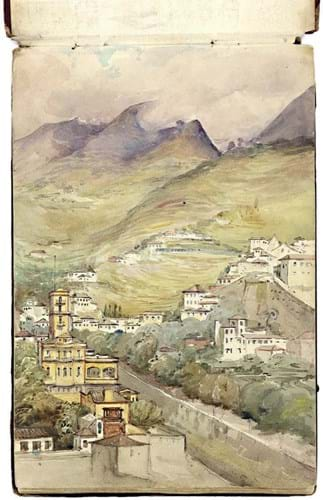
Watercolour depicting the town of Funchal in Madeira taken from a sketchbook by Emily Eden sold at £24,000 at Gorringe's.
Together they provide pictorial support to a journey that is well documented through Eden’s writings.
The album had descended in the family of Emily’s sister Mary before it was acquired by Gorringe’s vendor. Also guided here at £25,000-35,000, it took £24,000.
Social and political life
Sold at £2400 (estimate £250-350) was one of Emily’s journals penned between January 1 and March 29, 1828. Writing during the period of the government led for just five months by Frederick John Robinson (1782-1859), 1st Viscount Goderich, the 23 pages of text are dominated by court intrigue and politics.
“It would be a shorter plan to let Parliament meet and vote that last year has never existed - that this is 1827,” she quips.
However, it also contains a full record of Emily’s social engagements and cultural interests: the theatre (“Kemble’s Falstaff is a wonderful piece of acting but the whole play acts very heavily”); art galleries (“saw some drawings of birds by a Mr Audubon”); and literature (“overheard a couple settling how to break to her father their intention of marrying - it would have been an excellent scene for Miss Austen”).
All the key Eden lots sold to the same Indian buyer who purchased Arthur William Devis’ 1792 The Weavers.


